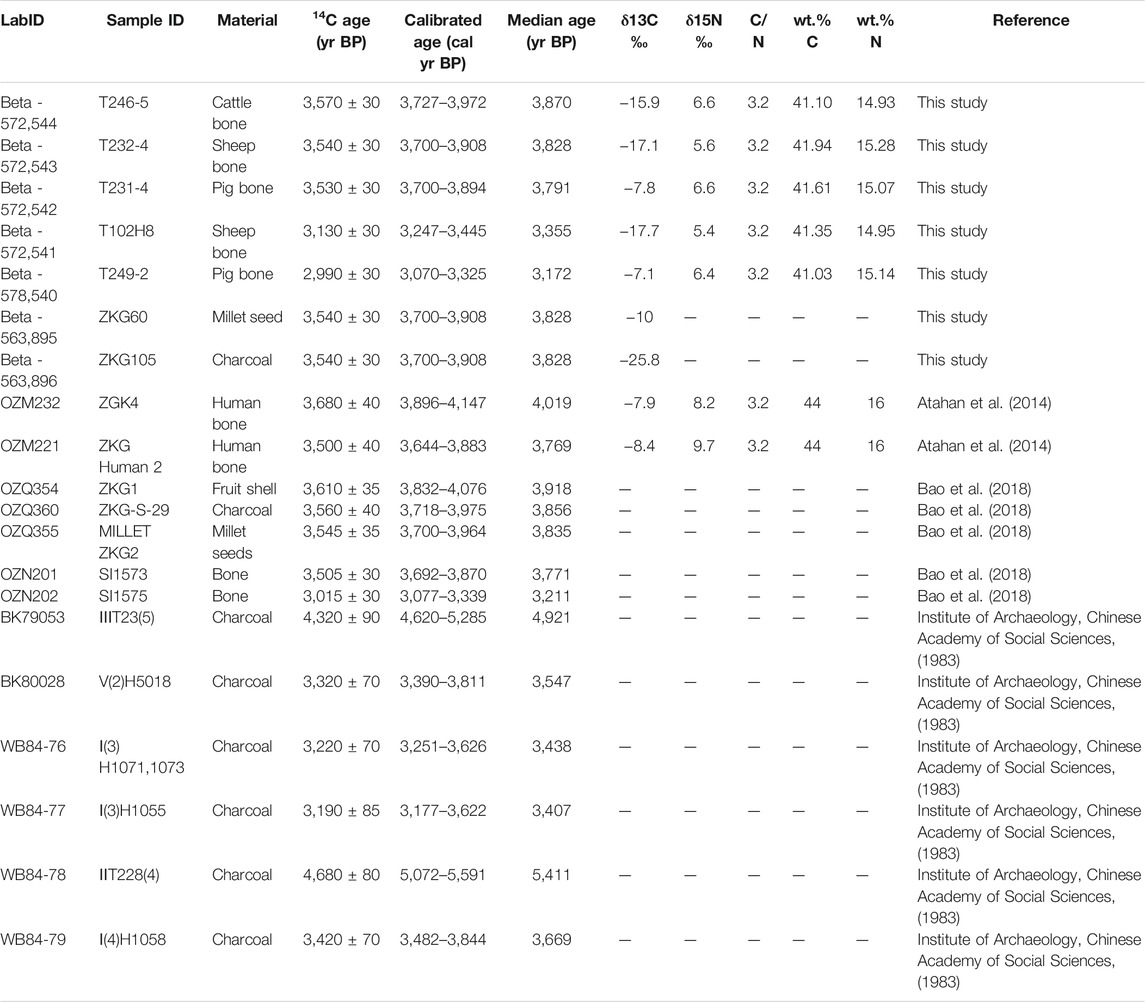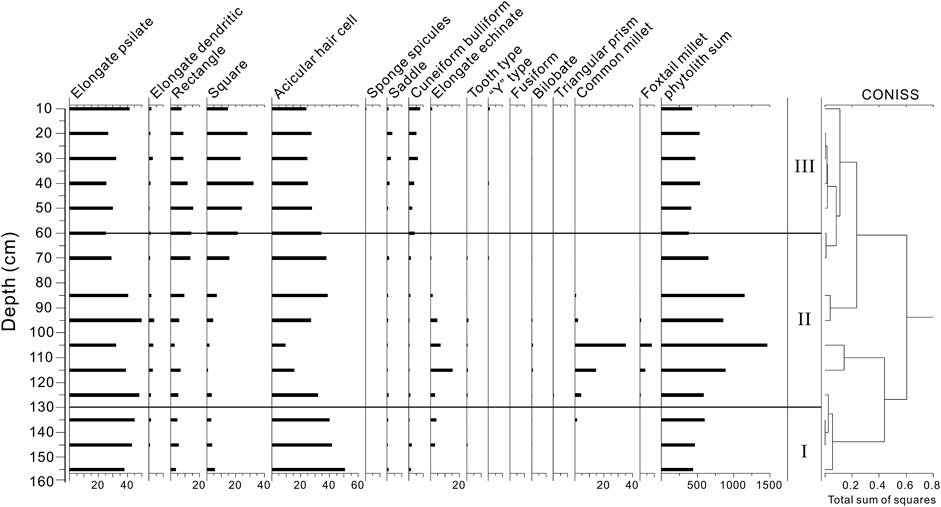- 1Key Laboratory of Vertebrate Evolution and Human Origins of the Chinese Academy of Sciences, Institute of Vertebrate Paleontology and Paleoanthropology, Chinese Academy of Sciences, Beijing, China
- 2Department of Earth Science, University of the Chinese Academy of Sciences, Beijing, China
- 3Institute of Tibetan Plateau Research, Chinese Academy of Sciences, Beijing, China
- 4Shaanxi Provincial Institute of Archaeology, Xi’an, China
- 5CAS Center for Excellence in Life and Paleoenvironment, Beijing, China
- 6Institute of Hydrogeology and Environmental Geology, Chinese Academy of Geological Sciences, Shijiazhuang, China
Eastern and Western Asia were important centers for the domestication of plants and animals and they developed different agricultural practices and systems. The timing, routeway and mechanisms of the exchanges between the two centers have long been important scientific issues. The development of a mixed pastoral system (e.g., with the rearing of sheep, goats and cattle) and millet cultivation in the steppe region of northern China was the result of the link between the two cultures. However, little detailed information is available about the precise timing and mechanisms involved in this mixture of pastoralism and millet cultivation. To try to address the issue, we analyzed the pollen, fungal spores and phytolith contents of soil samples from the Bronze Age Zhukaigou site in the steppe area of North China, which was combined with AMS 14C dating of charcoal, millet and animal bones. A mixed pastoralism and millet agricultural system appeared at the site between 4,000 and 3,700 cal yr BP, and the intensity of animal husbandry increased in the later stage of occupation. Published data indicate that domestic sheep/goats appeared across a wide area of the steppe region of northern China after ∼4,000 cal yr BP. A comparison of records of sheep/goat rearing and paleoclimatic records from monsoon area in China leads us to conclude that the mixture of pastoralism and millet cultivation was promoted by the occurrence of drought events during 4,200–4,000 cal yr BP. Moreover, we suggest that mixed rainfed agriculture and animal husbandry increased the adaptability and resilience of the inhabitants of the region which enabled them to occupy the relatively arid environment of the monsoon marginal area of northern China.
Introduction
The domestication of plants and animals greatly enhanced human adaptability to environmental changes and at the same time profoundly affected human cultural development and ultimately large urban centers (Zeder, 2008; Lv et al., 2009; Yuan, 2010). Western Asia, Eastern Asia and Central America were important centers for the early domestication of plants and animals. Barley (Hordeum vulgare), wheat (Triticum aestivum), cattle (Bos taurus), sheep (Ovis aries) and goats (Capra aegagrus) were originally domesticated in Western Asia. Rainfed agriculture, rice cultivation, together with the domestication of dogs (Canis familiaris) and pigs (Sus domestica) originated in Eastern Asia (pigs were also domesticated in SW Asia), while maize and alpacas were first domesticated in Central America (Cruz-Uribe, 1987; Fuller et al., 2010; Yuan, 2010; Lv, 2018). The exchange and mixture of different agricultural systems during the Holocene enabled humans to adapt to different environments and to environmental fluctuations. The timing, pathways and mechanisms of early agricultural cultural interactions (also known as food globalization) have long been considered an important topic in archaeology and global changes (Jones, 2007; Liu et al., 2019).
The Eurasian steppe is an important routeway of cultural exchanges between the East and West (Frachetti et al., 2012; Qu et al., 2020). Botanical archaeological research has revealed that wheat and barley cultivation spread to the Altay region of the Eurasian steppe as early as 5,200 cal yr BP (Zhou et al., 2020), and subsequently appeared in the Hexi Corridor and in the Shandong Peninsula in China between 4,300 and 4,000 cal yr BP (Dodson et al., 2013; Long et al., 2018). Millet cultivation was practiced in southeast Kazakhstan in Central Asia at ∼4,700 cal yr BP, and then spread westward at ∼4,000 cal yr BP (Betts et al., 1995; Jones, 2007; Miller et al., 2016; Wang et al., 2017; Hermes et al., 2019).
The spread of pastoralism represented by sheep/goat and cattle rearing provides important evidence for cultural interactions between the East and West. Domesticated sheep/goats appeared in the Mongolian steppe and then spread eastward and southward by at least 5,200 cal yr BP (Li and Song, 2018; Wilkin et al., 2020). Domestic cattle rearing can trace back to 5,500–5,300 cal yr BP at the Houtaomuga site in Northeast China (Cai et al., 2018). The earliest evidence for sheep rearing in China may be from the Shizhaocun and Hetaozhuang sites in the western Loess Plateau (Yuan, 2010). The context of the cultural layer indicated that the interval of sheep rearing was 5,000–5,600 cal yr BP, but the sheep bone have not yet been directly dated (Yuan, 2010). Two important questions regarding this evidence are how this animal husbandry was introduced to Eastern Asia, and whether it was imported together with wheat or other crops. More specially, the transmission mechanism of these agricultural practices, the timing of the domestication of sheep/goats and cattle, and the routeway of their dispersal are unknown.
The steppe of northern China is located in the eastern part of the Eurasian steppe belt, and it includes the steppe regions of the Northeastern Plain, the Inner Mongolia Plateau, the Ordos Plateau, and the Loess Plateau. Overall, these regions have long had a mixed agricultural and pastoral economy due to the arid and semiarid climate, with millet cultivation and animal husbandry (e.g., sheep, goats and cattle) being major components. The combination of millet cultivation, pig rearing and hunting and gathering was the dominant subsistence strategy of the region since before the mid-Holocene, which differs substantially from the agriculture practiced in the region today (Hu and Sun, 2005). The rearing of sheep, goats and cattle, together with other forms of animal husbandry, began to appear in the middle and late Holocene, eventually resulting in the development of a mixed agricultural system based on rainfed cultivation and animal husbandry. The development of this agro-pastoral system enabled the inhabitants of the region to adapt to its climate from wet to dry. However, there is a lack of detailed research on the relationship between the timing of the development of this agro-pastoral system and the environmental background (Zhao, 2006).
To attempt to address this knowledge gap we studied a section at the Zhukaigou (ZKG) site in the steppe region of northern China. Analyses of pollen, phytoliths, and the stable isotope composition of animal bones, combined with AMS14C dating and reference to published botanical and zoological archaeological evidence, enable us to determine the timing of the appearance of this mixed agricultural economy in the study area. We also compare the findings with records of the regional climatic and environmental evolution and develop a possible link between the development of agro-pastoralism and climate change.
Study Region
The Bronze Age site of ZKG is located in the eastern part of the Ordos Plateau in southern Inner Mongolia (Figure 1). The archaeological site was discovered in 1974, and so far it has been excavated four times. Archaeological excavations have revealed the remains of houses, ash pits, tombs, other relics, a large amount of pottery, stone artifacts, numerous bone artifacts, bronze artifacts, and abundant animal remains. The pottery type series include tripod jars, basins, pots, spindle whorls and so on. The stone artifacts include axes, chiels, knives and adzes. The Bronze ware includes the famous Ordos bronze dagger, a bronze knife and ornaments (Institute of Cultural relics and Archaeology, Inner Mongolia Autonomous region, 2000). The domestic animal remains excavated at the site include pigs, sheep, cattle and dogs, and wild animals include badger (Meles), bear (Ursus sp.), leopard (Panthera pardus), roe deer (Capreolus), red deer (Cervus elaphus), and goral (Noemorhedus goral) (Huang, 1996). In recent years, the study of archaeobotany has revealed that the inhabitants of the ZKG site grew common millet (Panicum miliaceum) and foxtail millet (Setaria italica) (Bao et al., 2018).
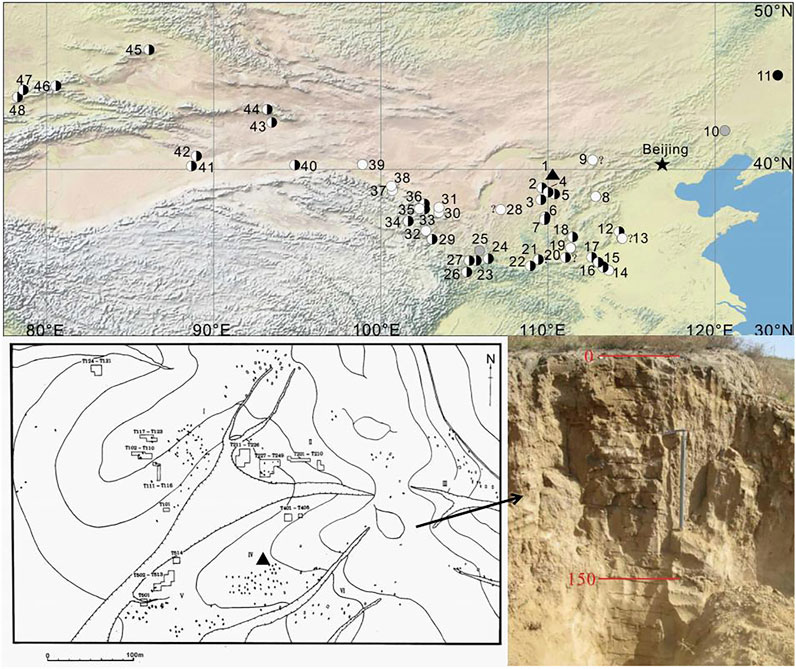
FIGURE 1. Location of the Zhukaigou site and other sites mentioned in the text. White and black circles indicate sites with the remains of domestic sheep/goat and cattle, respectively. Grey circles indicate sites without the remains of domestic sheep/goat and cattle. “?” indicates a site where it is uncertain whether the sheep/goat or cattle were domesticated. The sites names represented by the numbers are shown in Table 1. The Zhukaigou section and its location in the Zhukaigou site. The location map of Zhukaigou site was cited from the Institute of Cultural relics and Archaeology, Inner Mongolia Autonomous region, (2000).
Most of the Ordos Plateau, where the ZKG site is located, is a mixed agricultural-pastoral area, while the subsistence strategy in the Mu Us sandy land to the southwest is dominantly animal husbandry. The zonal vegetation is typical steppe dominated by Stipa bungeana and Stipa krylovii. Due to erosion, desertification and long-term human activities, desert vegetation has replaced the native steppe vegetation in most of the area. The main plant taxa are: Artemisia ordosica, Caragana, Sabina vulgaris Ant and Salicaceae. The annual average temperature of the region is 5.3–7.5°C and the annual precipitation is 270–400 mm. The climate is arid and semiarid.
Materials and Methods
Stratigraphy of the Zhukaigou Section
The ZKG section (39°6′N, 110°3′E) located in the southern of the site, which is 155 cm-deep (Figure 1) and contains evidence of human activities, such as pottery and charcoal. According to the color and structural characteristics of the sediments, the section is divided into four layers: 1) 0–40 cm: Light gray sandy silt with abundant charcoal fragments, large calcium carbonate nodules, and small pebbles. 2) 40–70 cm: Light yellow sandy silt with less charcoal than above; abundant larger calcium carbonate nodules, small gravel clasts and gray clay pottery. 3) 70–100 cm: Light gray sandy silt containing occasional charcoal fragments, small calcium carbonate nodules, pebbles and animal remains. 4) 100–155 cm: Pale yellow sandy silt layer containing a small amount of charcoal, fine gravel and gray clay. The natural soil layer is below the depth of 155 cm. In order to determine the age of the sedimentary section, charcoal and grains of millet were selected at the depths of 145 cm, 105 and 60 cm for AMS 14C dating.
AMS 14C Dating of Domesticated Animal Remains at the ZKG Site
Huang, (1996) suggested that the domesticated animals at the ZKG site consist of pigs, sheep and cattle, and they estimated the age of the remains based on AMS 14C dating of charcoal recovered from the strata. So far, however, there has been no direct AMS 14C dating of the remains of domesticated animals at the site, and therefore we selected animal bones from different cultural periods for AMS 14C dating. The AMS 14C dating was conducted at the Beta Laboratory, United States. The dated samples included two pig bones, two sheep bones and one cattle bone, from different cultural layers. The AMS 14C dating results were calibrated using IntCal20 in OxCal 4.3 software (Reimer et al., 2020).
3.3 Pollen and Phytolith Analysis
Fifteen pollen samples of ∼30 g weight were analyzed using conventional heavy liquid separation. A known number of Lycopodium spores was added prior to the preparation to calculate pollen concentrations. The identification of pollen and fungal spores was based on atlases of pollen morphology (Taylor, 1988; Xi and Ning, 1994; Wang et al., 1995; Van Geel et al., 2003; Tang et al., 2016). A pollen and fungal spores diagram was drawn and statistical zonation was conducted using CONISS implemented in Tilia 2.0 (https://www.tiliait.com/). The charcoal content was estimated using point counting. Fifteen samples of ∼10 g weight were used for phytolith analysis following the conventional wet oxidation method. Phytoliths were identified with reference to the phytolith key of Wang and Lv (1993), and a phytolith diagram was drawn using Tilia software.
Results
AMS 14C Dating Results
The AMS 14C dating results for the materials from the ZKG are illustrated in Figure 2 and listed in Table 1. The age of charcoal fragments at the depth of 145 cm in the ZKG section is 3,718–3,975 cal yr BP (OZQ360); and that of the depth of 105 cm is 3,700–3,908 cal yr BP (Beta 563,896); the age of carbonized seeds at the depth of 60 cm is 3,700–3,908 cal yr BP (Beta 563,895); and the age of cattle remains is 3,727–3,972 cal yr BP (median age of 3,870 cal yr BP, the same below). The ages of sheep and pig remains from the second cultural stage are 3,700–3,908 cal yr BP (3,828 cal yr BP) and 3,700–3,894 cal yr BP (3,791 cal yr BP). The age of sheep remains from the third cultural stage is 3,247–3,445 cal yr BP (3,355 cal yr BP). The age of pig remains from the fourth cultural stage is 3,070–3,325 cal yr BP (3,172 cal yr BP). Thus, the age range of the remains of domestic animals at the site is 3,070–3,972 cal yr BP. The published AMS 14C ages for the ZKG site are between 4,100 and 3,100 cal yr BP, except for two ages that are older than 4,500 years (Figure 2; Table 2).
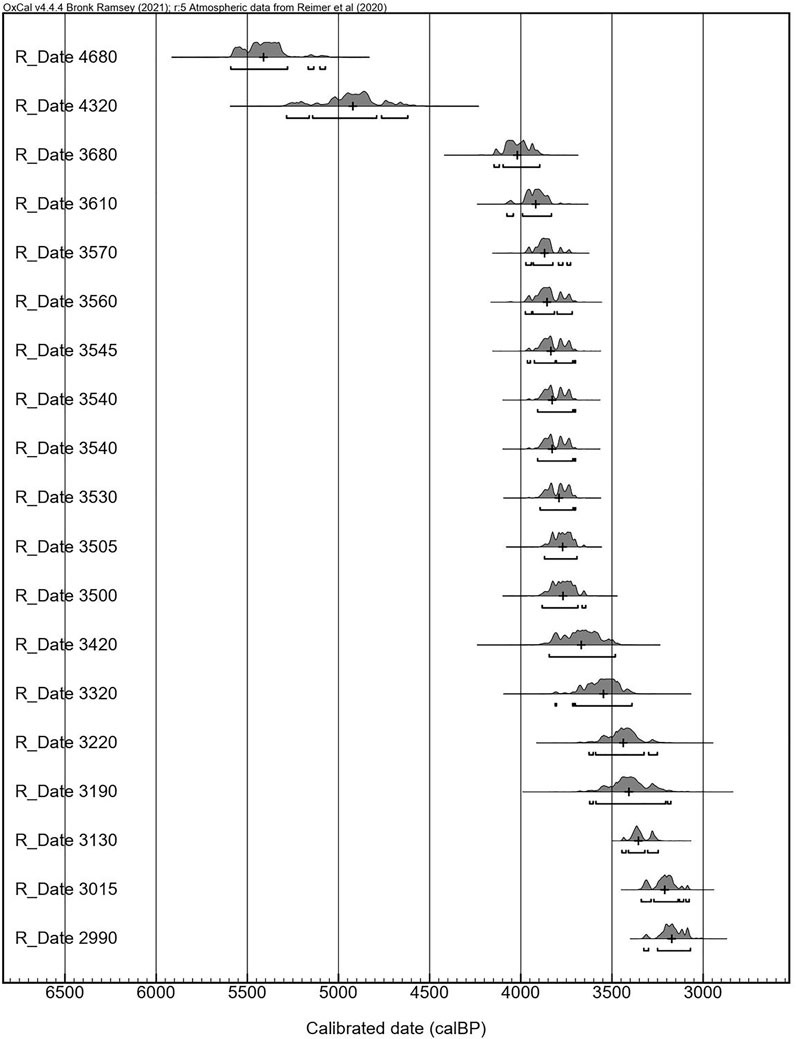
FIGURE 2. AMS 14C dating results for the samples from the ZKG site. “+” indicates the median age. The ages were determined using OXCAL 4.3 software with the INTCAL20 curve correction (Reimer et al., 2020).
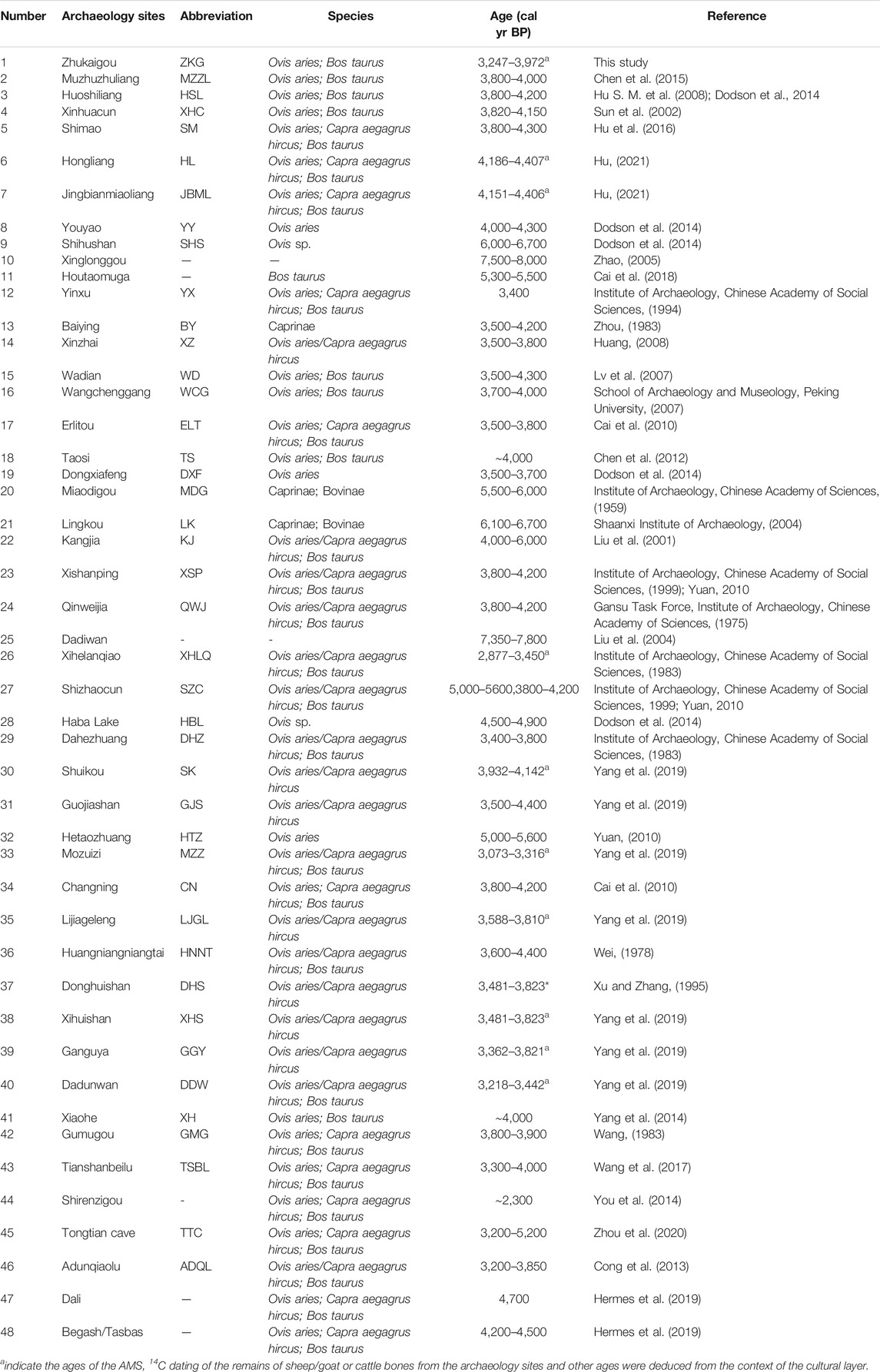
TABLE 1. The sites names represented by numbers in Figure 1 and their abbreviations in this study.
Pollen Analysis
A total of 4,445 pollen grains, comprising 18 families and genera, were identified from the 15 samples analyzed from the ZKG section (Figure 3). The main tree pollen types are Pinus, Betula, Ulmus and Fagaceae; and the main shrubs and herb pollen types are Artemisia, Chenopodiaceae, Ephedra, Asteraceae, Leguminosae, Tamarix, Polygonum, and Apiaceae. Ferns are rare and include Monoletes, Triletes and Polypodiaceae. The fungal spores are mainly Sporormiella and Srodaria. The pollen diagram (Figure 4) was divided into three zones according to CONISS, and are described below.
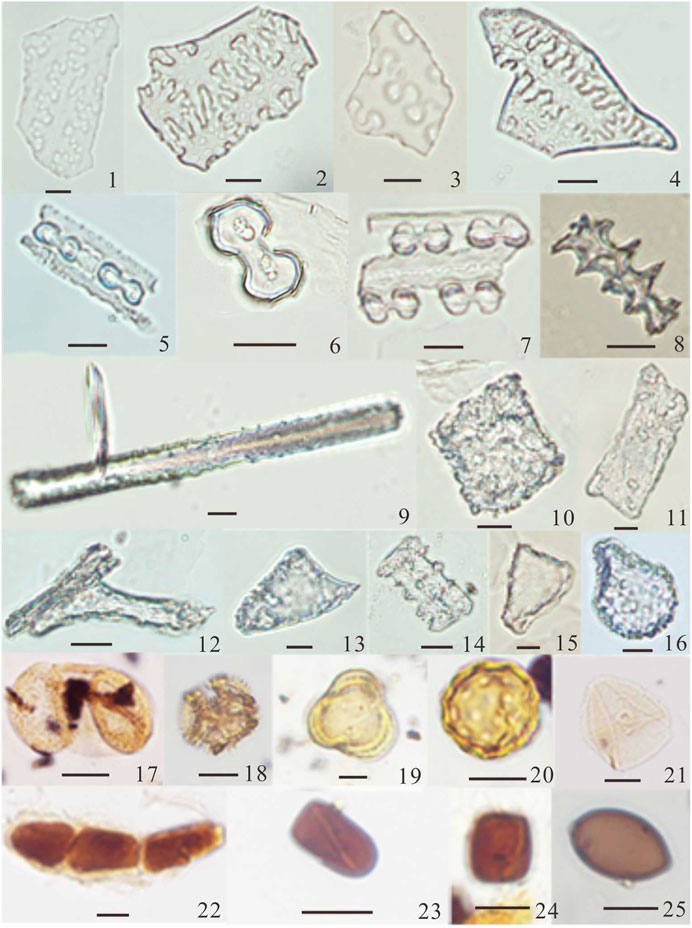
FIGURE 3. Phytoliths, pollen and fungal spores from the ZKG section. 1, 2, 4, Broomcorn millet husk; 3, Foxtail millet husk; 5-7, Bilobate; 8, Elongate dendritic; 9, Elongate psilate; 10, Square; 11, Rectangle; 12, “Y” type; 13, Acicular hair cell; 14, Tooth type; 15, Fusiform; 16, Cuneiform bulliform; 17, Pinus; 18, Compositae-Taraxacumtype 19, Artemisia; 20, Chenopodiaceae; 21, Poaceae; 22–24, Sporormiella; 25, Sordaria (black lines indicate 10 μm).
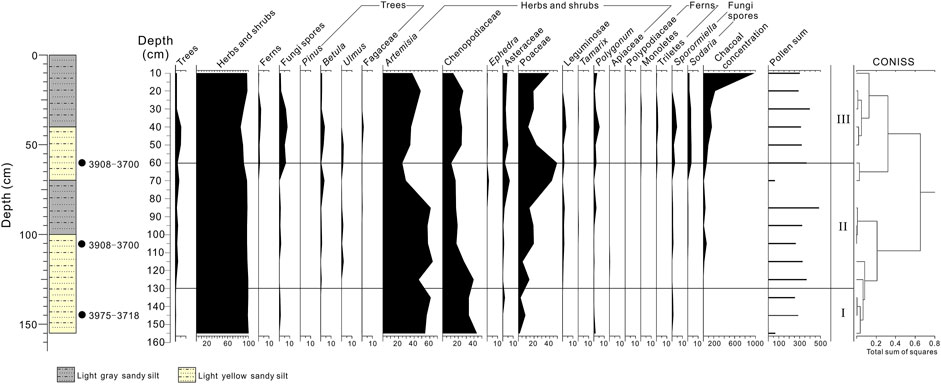
FIGURE 4. Pollen percentage diagram for the ZKG section (only the major taxa are shown). The contents of fungal spores and charcoal particles are also shown.
Pollen Assemblage Zone I (Artemisia-Chenopodiaceae): 155–130 cm. The zone is dominated by herbaceous pollen which is dominated by Artemisia (53.7–61.2%; average of 57%), followed by Chenopodiaceae (33.3–43.3%; average of 36.7%. Poaceae is relatively poorly represented (1.5–8.8%; average of 4.3%). The content of Sporormiella fungal spores is 0–1.1% (average of 0.6%). The charcoal concentration is low, with an average of 0.9 × 10−2 cm2 g−1.
Pollen Assemblage Zone II (Artemisia-Chenopodiaceae-Poaceae): 130–60 cm. There are substantial changes in the herbaceous taxa compared with Zone I, with a major decrease in Chenopodiaceae (10.4–39.2%; average of 20.8%) and an increase in Poaceae (5.5–49.3%; average of 23.5%). However, Artemisia is still well represented (23.9–63.9%; average of 48.4%). The content of fungal spores is slightly higher than in Zone I, including Sporormiella (0.0–2.7%; average of 0.8%) and Sordaria (0.0–3.6%; average of 0.7%. The concentration of charcoal particles is higher than in the Zone I (1.2–61.8 × 10−2 cm2 g−1; average of 26.9 × 10−2 cm2 g−1).
Pollen Assemblage Zone III (Artemisia-Chenopodiaceae-Poaceae): 60–0 cm. Artemisia (34.7–48.3%, average of 39.6%) and Chenopodiaceae (13.3–26.2%; average of 21.8%) are well represented. The representation of Poaceae (12.5–39%, average of 22.7%) is similar to that of Zone II. There is a substantial increase in the representation of fungal spores, including Sporormiella (0–4.5%; average of 1.8%) and Sordaria (1.3–3.4%; average of 2.5%). The concentration of charcoal fragments is substantial higher than in Zone II (93–968 ×10–2 cm2 g−1).
Phytolith Analysis
A total of 9,630 phytoliths were identified in the 15 samples from the ZKG section, comprising 16 taxonomic categories (Figure 3). The main morphotypes are: Elongate psilate, Elongate dendritic, Rectangle, Square, Acicular hair cell, Sponge spicules, Saddle, Cuneiform bulliform, Elongate echinate, Tooth type, “Y” type, Fusiform, Bilobate, Triangular prism, and common millet and foxtail millet. The morphotypes for common millet and foxtail millet are “η” and “Ω”, repectively (Lv et al., 2009). And they come from husks. There are few other Panicoideae phytoliths in the samples. The phytoliths are dominated by Elongate psilate (25.1–49.9%) and Acicular hair cell (11.2–50.6%). The phytoliths of common millet and foxtail millet occur within the depth interval of 70–135 cm; the lowest representation is 0.2% at a depth of 70 cm and the highest is at 105 cm, representing 33.4 and 41.1% of total phytoliths, respectively. Based on the cluster analysis, the phytolith records can also be divided into three zones (Figure 5):
Zone I (155–130 cm). The total numbers of phytoliths in zone I are 1,483. Elongate psilate type (37.8–45%) and Acicular hair cell type (40.1–50.6%) are the most common phytoliths. Common millet (1.2%) occurs in a single sample at the depth of 135 cm.
Zone II (130–60 cm). The total numbers of phytoliths in zone II are 5,571. Elongate psilate type (25.1–49.9%) remains the most common phytolith type, and there is a decrease in the Acicular hair cell type (9.6–38.7%). There are increases in the common millet (0–35.1%) and foxtail millet phytolith types (0–7.9%).
Zone III (60–0 cm). The total numbers of phytoliths in zone III are 2,734. The Elongate psilate type (25.3–41.3%) and Acicular hair cell type (24–27.8%) continue to decrease. Square (14.7–32.3%) and Rectangle (7.4–15.4%) increase substantially, and there is a slight increase in the Cuneiform bulliform type. However, the common millet and foxtail millet types disappear.
Discussion
The Agro-Pastoral Economy at the ZKG Site
Phytoliths are tiny siliceous bodies precipitated in plant cells and deposited in the soil. They have distinct morphological characteristics due to differences in plant cell structure and soil type, and moisture and climatic conditions. As an important biological indicator, phytoliths have been widely used in research in palaeovegetation, palaeoecology and agricultural archaeology (Lv et al., 2009).
The phytoliths of common millet and foxtail millet in the section are direct evidence of the cultivation of the parent plants at the site, and are consistent with the discovery of millet seeds and associated agricultural tools at the site (Institute of Cultural relics and Archaeology, Inner Mongolia Autonomous region, 2000; Bao et al., 2018). The AMS 14C ages of two crop seeds from the ZKG site are 3,700 and 4,000 cal yr BP (median ages of 3,835 and 3,828 cal yr BP, respectively). There is a relatively high abundance of phytoliths in the sediments within this period, indicating that millet was cultivated in the vicinity of the site, and that there was a high intensity of planting activity (Figure 6). Phytoliths are absent from the sediments above 60 cm in the ZKG section, which may have been caused by a reduction in rainfed agriculture at the site.
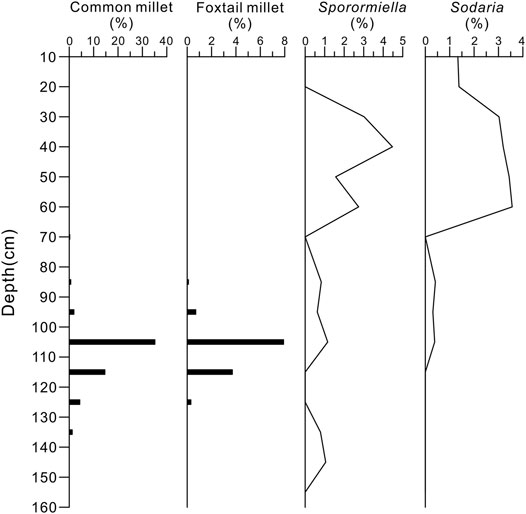
FIGURE 6. Contents of common millet and foxtail millet phytoliths and fungal spores inthe ZKG section.
The life cycle of fungal spores is closely related to the activity of herbivores. After breaking dormancy in the intestinal tract of animals, the spores are excreted and then propagate (Van Geel et al., 2011). Many studies have shown that fecal fungal spores can be used as indicators of domestic herbivores (Van Geel et al., 2003; Zhao et al., 2013; Huang et al., 2020, 2021). Therefore, the occurrence of fungal spores in the sediments of the ZKG site indicates the local presence of herbivorous domestic animals, which is consistent with the large quantity of domestic animal remains excavated from the site (Huang, 1996). The distribution of fungal spores in the strata is characterized by low percentages below the depth of 60 cm, indicating limited cattle and sheep rearing at that time, while the increased percentages above 60 cm indicate that animal husbandry increased (Figure 6).
The carbon isotope composition (δ13C) of the bones of domesticated pigs, cattle and sheep can reflect their diet and hence human feeding strategies (Hu S. M. et al., 2008; Chen et al., 2012). The δ13C values of carbon isotopes of two pig bones from the ZKG site are −7.1‰ (3,791 cal yr BP) and −7.2‰ (3,172 cal yr BP), which indicates that their food was dominated by C4 plant types. The δ13C values of pigs are similar to those of human bones at the ZKG site (Atahan et al., 2014) (Table 2); moreover, the δ13C values of the bones of humans and domestic pigs in North China are similar (Hu Y. W. et al., 2008). The δ13C values of cattle and sheep indicate that C3 plants were the dominant plant types consumed by these animals at the ZKG site. The δ13C of cattle is also ∼1‰ more positive than that of sheep, which may be related to the consumption of cultivated millet and millet byproducts. The Taosi site in the Central Plains is an important symbol of Chinese large urban centers (Figure 1; Table 1). The δ13C values (average −11.25‰) of cattle bones at the Taosi site are indicative of a diet dominated C4 plants, which may reflect the supply of fodder by humans (Chen et al., 2012). However, the δ13C values of cattle bones at ZKG indicates that a lower proportion of C4 plants was consumed than at the Taosi site.
The evidence provided by the contents of phytoliths and fungal spores of the section, combined with the archaeological evidence, reveals that a mixed agro-pastoral economy consisting of rainfed millet cultivation and animal husbandry (cattle and sheep) appeared at the ZKG site some 4,000 years ago. However, there were changes in the relative proportions of rainfed millet cultivation and pastoralism over time. Rainfed millet cultivation accounted for a high proportion of the agricultural activity in the early phase, but the proportion of pastoral activity increased subsequently. The nitrogen isotope composition (δ15N) of two human bones from ZKG were 8.2 and 9.7‰ (median ages of 4,019 cal yr BP and 3,769 cal yr BP, respectively). The 1.5‰ difference between the two indicates an increase of the nitrogen intake and hence an increase in animal husbandry (Atahan et al., 2014). Pig bones dating back 3,200 years have been found at the ZKG site, and pig rearing is direct evidence of settled agriculture. Although there may have been cultural or genetic exchanges with the Andronovo culture (Institute of Cultural relics and Archaeology, Inner Mongolia Autonomous region, 2000; Jeong et al., 2020; Wang et al., 2021), the area remained dominated by a settled agro-pastoral economy from the middle to the late Bronze Age (4,000–5,000 cal yr BP).
Agro-Pastoralism in the Steppe Region of Northern China
In the early mid-Holocene, human activity in the forest and steppe region of northern China mainly took the form of rainfed agriculture and pig rearing. For example, millet cultivation appeared at the Xinglonggou site in the West Liaohe River Basin between 8,000 and 7,500 cal yr BP (Zhao, 2005), and at the Dadiwan site, in the western part of the Loess Plateau, at 7,800–7,350 years cal yr BP (Liu et al., 2004). Pig rearing was also conducted at both sites. Agricultural tools have been excavated from Shihushan (6,700–6,000 cal yr BP), Wangmushan (5,300–4,900 cal yr BP), Xiyuan (5,000–4,800 cal yr BP) and Ashan (4,400–3,800 cal BP) in the northern Loess Plateau and in the Hetao area of the Ordos Plateau (Yang, 1997; Bao et al., 2018; Feng and Wei, 2018). We speculate that they are related to millet agriculture. But usewear and residue analyses on food processing stone tools from these sites have shown that plants including tubers are dominant (Liu et al., 2014; 2016). The seeds have been found from Xiaojiamao, Dakou, Zhaimao, Zhukaigou, Shimao sites (Bao et al., 2018). Millet, a C4 plant, was an important food source for humans in the steppe region of northern China during 2,500–5,000 cal yr BP, then the ratio of C3 plants in the diet began to increase after 2,500 cal yr BP (Atahan et al., 2014).
Evidence of cattle and sheep rearing gradually appeared in the region in the middle and late Holocene (from the time of the Longshan culture to the Bronze Age). For example, AMS 14C ages of the remains of domestic cattle at Houtaomuga of 5,500–5,300 cal yr BP were obtained (Cai et al., 2018). AMS 14C ages of 4,577–4,454 cal yr BP were obtained for cattle remains at the Ashan site, but it is unclear if they were domesticated (Bao et al., 2018). The latest AMS 14C dating of cattle bone from the Hongliang site were 4,406–4,186 cal yr BP (Hu, 2021). The first directly cattle bones for the Hexi Corridor region, with the samples dating to 3,850–3,700 cal yr BP (Brunson et al., 2020). The earliest evidence of domestic sheep/goats in China may be at the Shizhaocun and Hetaozhuang sites in the western Loess Plateau; the estimated age range is 5,600–5,000 cal yr BP based on the archaeological context, but no direct AMS 14C ages were reported (Yuan, 2010).
So far, published AMS 14C ages for the remains of the earlist domesticated sheep/goats come from the Youyao (4,292–4,029 cal yr BP) site (Dodson et al., 2014). AMS 14C ages of 4,406–4,151 cal yr BP were obtained for three sheep bones at the Jingbianmiaoliang site (Hu, 2021). An AMS 14C age of 3,925 cal yr BP was obtained for sheep skin at Gumugou in Xinjiang (Wang, 1983). The dating results for mixed human and sheep bones from Xihe Lanqiao in Gansu Province are 3,450–2,877 cal yr BP (Chinese Archaeological Radiocarbon Collection, 1983). In addition, the AMS 14C dating results for sheep/goat bones from Hexi Corridor are 4,413–3,073 cal yr BP (Yang et al., 2019). Other dates for sheep or cattle remains have been obtained for the sites of Shimao (4,300–3,800 cal yr BP), Muzhuzhuliang (∼4,000 cal yr BP) and Zhengzemao (∼4,800 cal yr BP) in Shaanxi Province; Yongxingdian in Zhunger Qi in Inner Mongolia Province (4,450–3,950 cal yr BP); Dakou (4,200–3,500 cal yr BP) and Taosi in Shanxi Province (∼4,000 cal yr BP); and Yuanqu Shangcheng (3,300–2,800 cal yr BP), Tongtian cave (5,200–3,200 cal yr BP), Adunqiaolu (3,850–3,200 cal yr BP), Xiaohe (4,000 cal yr BP) and Shirenzigou (2,300 cal yr BP) in Xinjiang. However, no direct AMS 14C dating has been reported (Figure 6) (Wei, 2000; Cong et al., 2013; You et al., 2014; Yu et al., 2018).
Opposite to the eastern end of the Eurasian steppe (including the steppe region of northern China), the Yamnaya culture (5,300–4,200 cal BP) originated in the western part of the Eurasian steppe and practiced an economy based on hunting and grazing. The Yamnaya people spread eastward and reached Lake Baikal, which was the eastern limit of their extension (Zhou et al., 2020; Wang et al., 2021; Narasimhan, et al., 2019). The Afanasyevo culture (5,000–3,500 cal yr BP), which was believed to have been formed by the eastward spread of the Yamnaya culture (Cong and Jia, 2020; Honeychurch et al., 2021). And the Afanasyevo culture which appeared in the central Eurasian steppe, was characterized by sheep/goat and cattle rearing (Honeychurch et al., 2021). During the middle and late Bronze Age, the Andronovo culture (1900–1,500 cal yr BP) developed in the central Eurasian steppe. Several studies have proposed that practiced a sedentary from of animal grazing, and raised animals such as horses, sheep/goat and cattle (Kuzmina, 2008).
According to recent ancient DNA research, during the early Bronze Age there was a possible cultural connection between the populations of Yamnaya and the Eastern Eurasian steppe (Wang et al., 2021). The economy of the steppe of northern China at this time was dominated by rainfed agriculture and pig rearing. Cattle and sheep/goat were also raised sporadically, but did not play the dominant role. By the middle to late Bronze Age, cattle and sheep/goat rearing had increased substantially, similar to the subsistence economy of the Andronovo culture, but horse raising was uncommon. According to this study, the mixed economy of rainfed agriculture and cattle and sheep/goat rearing in the steppe region of northern China was practiced as early as 4,000 years ago. In addition to cultural influences from the central and western steppe areas, climatic and environmental changes were an important factor that must be considered when interpreting patterns of subsistence activity, which is discussed below.
Climatic Influence on the Mixture of Pastoralism and Millet Cultivation in the Steppe Region of Northern China
The steppe region of northern China, dominated by arid and semiarid ecosystems, is located on the margin of the zone of influence of the Asian summer monsoon. A shift in the East Asian monsoon occurred some 4,000 years ago and it had an important impact on the environment of East Asia. Stalagmite records from Dongge Cave show that the intensity of the Asian summer monsoon weakened from 4,400 years BP to 3,900 years BP corresponding to a decrease in North Atlantic sea surface temperatures (Bond et al., 1997; Demenocal et al., 2000; Wang, 2017) (Figure 7). Pollen records and quantitative palaeoclimatic reconstructions from Gonghai in Taihang Mountain and Tianchi in Liupan Mountain indicate a substantial decrease in precipitation in the monsoon margin zone at ∼4,000 years BP (Zhang et al., 2010; Chen, 2015; Li et al., 2017). Additionally, the pollen percentages of Chenopodiaceae increased significantly during 4,400–3,350 cal yr BP at Hulun Lake, indicating arid climatic conditions (Wen et al., 2010).
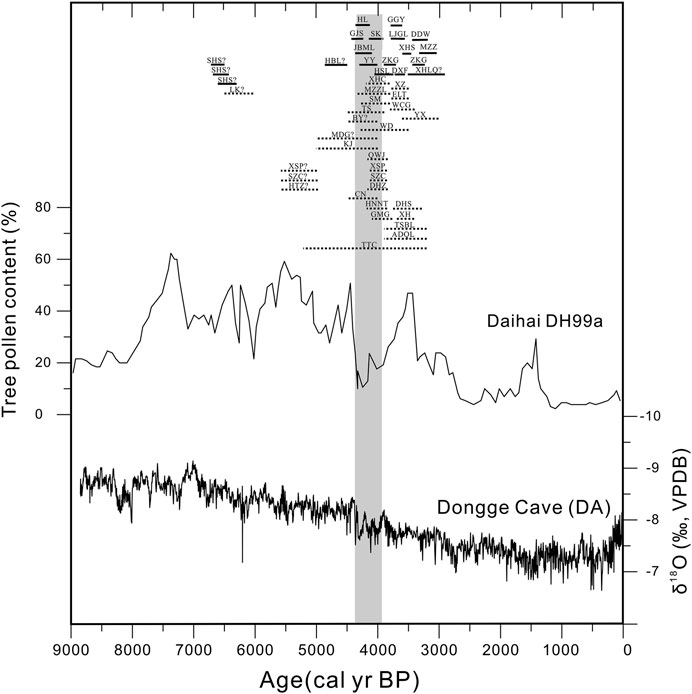
FIGURE 7. Ages of the remains of domestic sheep at sites in North China (solid line indicates AMS 14C ages, dashed line indicates age inferred from the cultural context, and “?” indicates that it is uncertain whether the sheep were domesticated). Also shown are tree pollen percentages from Daihai (Xiao et al., 2004) and the oxygen isotope record from Dongge cave (Wang et al., 2017). The grey shading represents drought events at ∼4,200 cal yr BP. The full names of the sites are shown in Table 1.
According to a comprehensive study of environmental and archaeological records (Cui et al., 2019; Sun et al., 2019), the decline of major Neolithic cultures in China was closely related to the weakening of the monsoon some 4,000 years ago. Neolithic cultures, such as the Qijia, Laohushan, Hongshan, Longshan and Liangzhu, all declined and ended in or after this period (Wu and Liu, 2001; Mo et al., 2003; An et al., 2005; Yang et al., 2015).
Major drought events at ∼4,000 cal yr BP and their impacts may have been of global extent. The drought event during 4,200–3,900 years BP caused the abrupt decline of the Akkadian empire in Mesopotamia; and large urban centers in Egypt, on the Nile, and in India, on the Indus, also declined at the same time. Moreover, large urban centers in Anatolia, Aegean and Levant also developed during the Bronze Age (Weiss et al., 1993; Weiss and Bradley, 2001). The occurrence of severe droughts is suggested to have been a major cause of the declines of these large urban centers, on the one hand, and on the rise of a nomadic culture in steppe regions (Weiss and Bradley, 2001).
Tree pollen percentages in the Daihai DH99 drill core decreased substantially during 4,450–3,950 cal yr BP, while herb pollen types increased, indicating a pronounced cold and dry interval in the marginal area of the summer monsoon zone (Xiao et al., 2004) (Figure 7). The pollen record from the Zhukaigou site also suggests typical steppe vegetation, dominated by Artemisia and Chenopodiaceae, that would have favored the development of cattle and sheep rearing. Sheep/goats and cattle may have appeared in northern China some 5,000 years ago, but they were not universally raised. The period after the 4,200 years BP drought event, with substantially decreased precipitation and the expansion of steppe vegetation, coincided with a substantial increase in the numbers of domestic cattle and sheep (Figure 7). The low crop yields during this arid period may have been insufficient to support the population, while on the other hand the steppe vegetation benefited a pastoral economy. It is evident that the inhabitants of the region were able to adapt to these major environmental changes and adopt a modified economic structure which enabled the population carrying capacity of the land to be maintained. Therefore, we suggest that the combination of rainfed agriculture and pastoralism increased the adaptability of the inhabitants of northern China to arid conditions and increased their socioeconomic resilience.
Conclusion
A combined analysis of fungal spores, pollen and phytoliths of a sedimentary section at the Bronze Age ZKG archaeological site, combined with the results of AMS 14C dating of domestic animal remains, reveals that the inhabitants of the site relied on millet cultivation and pastoralism. The intensity of pastoralism increased from the early to the late stage at the site. The mixture of pastoralism and millet cultivation was common in the steppe region of northern China after ∼4,000 cal yr BP. The 4,200 years BP climatic event was likely an important factor responsible for the development of a mixed agro-pastoral economy in the region.
Data Availability Statement
The original contributions presented in the study are included in the article/supplementary material, further inquiries can be directed to the corresponding author.
Ethics Statement
Ethical review and approval was not required for the animal study in accordance with the local legislation and institutional requirements.
Author Contributions
YaZ and KZ did the research and wrote the article. YiZ identified the animal materials. SH and XZ participated in the research and offered suggestions for the article. LL participated in the identification of phytoliths experiment. JL participated in stable isotope experiment. XL guided the experiment and offered suggestions for the article.
Conflict of Interest
The authors declare that the research was conducted in the absence of any commercial or financial relationships that could be construed as a potential conflict of interest.
The handling editor declared a shared affiliation with several of the authors (YZ, YZ, XZ, LL, JLKZ, XL) at time of review.
Publisher’s Note
All claims expressed in this article are solely those of the authors and do not necessarily represent those of their affiliated organizations, or those of the publisher, the editors and the reviewers. Any product that may be evaluated in this article, or claim that may be made by its manufacturer, is not guaranteed or endorsed by the publisher.
Acknowledgments
We thank Professor Yunping Huang for providing the materials. We are grateful to professor John Dodson and Pia Atahan for their great help on the article. We thank Guanhan Chen for his suggestions on the AMS 14C dating model. Thanks for the support of National Natural Science Foundation of China (41772371,41730319), the Major Project of the National Social Science Foundation of China (18ZDA218) and the Youth Promotion Association of the Chinese Academy of Sciences.
References
An, C.-B., Tang, L., Barton, L., and Chen, F.-H. (2005). Climate Change and Cultural Response Around 4000 Cal Yr B.P. In the Western Part of Chinese Loess Plateau. Quat. Res. 63 (3), 347–352. doi:10.1016/j.yqres.2005.02.004
Atahan, P., Dodson, J., Li, X., Zhou, X., Chen, L., Barry, L., et al. (2014). Temporal Trends in Millet Consumption in Northern China. J. Archaeological Sci. 50 (50), 171–177. doi:10.1016/j.jas.2014.07.012
Bao, Y., Zhou, X., Liu, H., Hu, S., Zhao, K., Atahan, P., et al. (2018). Evolution of Prehistoric Dryland Agriculture in the Arid and Semi-arid Transition Zone in Northern China. PLoS ONE 13 (8), e0198750. doi:10.1371/journal.pone.0198750
Betts, A., Eames, A., Schroder, S., and Maria, E. (1995). Archaeological Survey of the Wadi Al-Ajib, Al-Mafraq.
Bond, G., Showers, W., Showers, W., Cheseby, M., Lotti, R., Almasi, P., et al. (1997). A Pervasive Millennial-Scale Cycle in North Atlantic Holocene and Glacial Climates. Science 278, 1257–1266. doi:10.1126/science.278.5341.1257
Brunson, K., Lele, R., Xin, Z., Xiaoling, D., Hui, W., Jing, Z., et al. (2020). Zooarchaeology, Ancient mtDNA, and Radiocarbon Dating Provide New Evidence for the Emergence of Domestic Cattle and Caprines in the Tao River Valley of Gansu Province, Northwest China. J. Archaeological Sci. Rep. 31, 102262. doi:10.1016/j.jasrep.2020.102262
Cai, D. W., Tang, Z. W., Chen, Q. J., Han, L., and Zhou, H. (2010). Molecular Archaeology of the Origin of Sheep in China. Front. Archaeol Res. 1, 291–298. (in Chinese).
Cai, D., Zhang, N., Zhu, S., Chen, Q., Wang, L., Zhao, X., et al. (2018). Ancient DNA Reveals Evidence of Abundant Aurochs (Bos Primigenius) in Neolithic Northeast China. J. Archaeological Sci. 98, 72–80. doi:10.1016/j.jas.2018.08.003
Chen, F., Xu, Q., Chen, J., Birks, H. J. B., Liu, J., Zhang, S., et al. (2015). East Asian Summer Monsoon Precipitation Variability since the Last Deglaciation. Sci. Rep. 5, 11186. doi:10.1038/srep11186
Chen, X. L., Guo, X. N., Hu, Y. W., Wang, W. L., and Wang, C. S. (2015). Analysis on the Diet of Ancestors in Shenmuzhuzhuliang Site, Shaanxi. Archaeology Cult. Relics 211 (05), 112–117. (in Chinese).
Chen, X. L., Yuan, J., Hu, Y. W., He, N., and Wang, C. S. (2012). A Preliminary Study on Livestock Rearing Strategy at Taosi Site: Evidence from Stable Carbon and Nitrogen Isotopes. Archaeology 09 (73), 76–83. (in Chinese).
Cong, D. X., and Jia, W. M. (2020). A Review of Prehistoric Nomadic Archaeology in the Eurasian Steppe from the Perspective of Prehistoric Subsistence Patterns. West. Res. 4. (in Chinese).
Cong, D. X., Jia, X. B., Guo, W., Shang, G. J., and Ge, L. (2013). Adunqiaolu Site and Cemetery in Wenquan County, Xinjiang. Archaeol (7), 25–32. (in Chinese).
Cruz-Uribe, K. (1987). Zooarcheology: The Archaeology of Animals . Simon J. M. Davis. Yale University Press, New Haven, CT, 1987. 224 pp., Illus. $27.50. Science 238 (4828), 833–834. doi:10.1126/science.238.4828.833.b
Cui, J., Sun, Z., Burr, G. S., Shao, J., and Chang, H. (2019). The Great Cultural Divergence and Environmental Background of Northern Shaanxi and its Adjacent Regions during the Late Neolithic. Archaeological Res. Asia 20, 100164. doi:10.1016/j.ara.2019.100164
Demenocal, P., Ortiz, J., Guilderson, T., and Sarnthein, M. (2000). Coherent High- and Low-Latitude Climate Variability during the Holocene Warm Period. Science 288 (5474), 2198–2202. doi:10.1126/science.288.5474.2198
Dodson, J., Dodson, E., Banati, R., Li, X., Atahan, P., Hu, S., et al. (2014). Oldest Directly Dated Remains of Sheep in China. Sci. Rep. 4, 7170. doi:10.1038/srep07170
Dodson, J. R., Li, X. Q., Zhou, X. Y., Zhao, K. L., Sun, N., and Atahan, P. (2013). Origin and Spread of Wheat in China. Quat. Sci. Rev. 72 (108), 111. doi:10.1016/j.quascirev.2013.04.021
Feng, B., and Wei, J. (2018). A Preliminary Study on the Pattern of Production of Shihushan Type. J. Agricul. Archaeol. 160 (06), 22–29. (in Chinese).
Frachetti, M. D., Anthony, D. W., Epimakhov, A. V., Hanks, B. K., Doonan, R. C. P., Kradin, N. N., et al. (2012). Multiregional Emergence of Mobile Pastoralism and Nonuniform Institutional Complexity across Eurasia. Curr. Anthropol. 53 (1), 2–38. doi:10.1086/663692
Fuller, D. Q., Allaby, R. G., and Stevens, C. (2010). Domestication as Innovation: The Entanglement of Techniques, Technology and Chance in the Domestication of Cereal Crops. World Archaeology 42 (1), 13–28. doi:10.1080/00438240903429680
Gansu Task Force, Institute of Archaeology, Chinese Academy of Sciences (1975). Qingweijia Qi Cultural Cemetery, Yongjing, Gansu Province. Archaeol J.. (in Chinese).
Hermes, T. R., Frachetti, M. D., Doumani Dupuy, P. N., Mar'Yashev, A., Nebel, A., and Makarewicz, C. A. (20191910). Early Integration of Pastoralism and Millet Cultivation in Bronze Age Eurasia. Proc. R. Soc. B. 286, 20191273. doi:10.1098/rspb.2019.1273
Honeychurch, W., Rogers, L., Amartuvshin, C., Diimaajav, E., Erdene-Ochir, N.-O., Hall, M. E., et al. (2021). The Earliest Herders of East Asia: Examining Afanasievo Entry to central mongolia. Archaeological Res. Asia 26, 100264. doi:10.1016/j.ara.2021.100264
Hu, S. M., and Sun, Z. Y. (2005). Analysis of Zoological Releases and Paleo Environment in Wuzhuangguoliang, Jingbian, Northern Shaanxi. Archaeology Cult. Relics. (in Chinese).
Hu, S. M. (2021). The Development of Animal Husbandry from the Perspective of Archaeology in Yulin Area-Based on the Animal Archaeology and the Latest Dating Data from 5000-4000 Years Ago in Yulin Area. Beijing, China: Chinese Journal of Social Science Special issue of National Social Science Foundation. (in Chinese).
Hu, S. M., Yang, M. M., Sun, Z. Y., and Shao, J. (2016). Study on Animal Remains Unearthed from Shimao Site in Shenmu, Shaanxi Province during 2012-2013. Archaeology Cult. Relics. doi:10.3969/j.issn.1000-7830.2016.04.012. (in Chinese)
Hu, S. M., Zhang, P. C., and Yuan, M. (2008). A Study on the Faunal Remains from the Huoshiliang Site in Yulin, Shaanxi. Acta Anthropol. Sinica. 27, 232–248. (in Chinese).
Hu, Y. W., Luan, F. S., Wang, S. G., Wang, C. S., and Richards, M. P. (2008). A Preliminary Attempt to Distinguish Domestic Pig from Wild Boar by C,N Stable Isotope Analysis. Sci. China: Ser. D 6, 693–700. (in Chinese).
Huang, X., Zhang, J., Ren, L., Zhang, S., and Chen, F. (2021). Intensification and Driving Forces of Pastoralism in Northern China 5.7 Ka Ago. Geophys. Res. Lett. 48, e2020GL092288. doi:10.1029/2020GL092288
Huang, X., Zhang, J., Storozum, M., Liu, S., Gill, J. L., Xiang, L., et al. (2020). Long-term Herbivore Population Dynamics in the Northeastern Qinghai-Tibetan Plateau and its Implications for Early Human Impacts. Rev. Palaeobotany Palynology 275, 104171. doi:10.1016/j.revpalbo.2020.104171
Huang, Y. P. (1996). Identification and Study of Animal Bone at Zhukaigou Site in Inner Mongolia. Archaeol. J. (4), 156–161. (in Chinese).
Huang, Y. P. (2008). Research on Animal Remains, Xinmixinzhai. Beijing, China: Cultural Relics Publishing House, 446–483. (in Chinese).
Institute of Archaeology, Chinese Academy of Sciences (1959). Miaodigou and Sanli Bridge. Beijing, China: Science Press. (in Chinese).
Institute of Archaeology, Chinese Academy of Social Sciences (1983). Data Sets of the 14C in Chinese Archaeology. Beijing, China: Cultural Relics Publishing House. (in Chinese).
Institute of Archaeology, Chinese Academy of Social Sciences (1994). Discovery and Research of Yinxu. Beijing, China: Science Press, 415–416. (in Chinese).
Institute of Archaeology, Chinese Academy of Social Sciences (1999). Shizhaocun and Xishanping. Beijing, China: Encyclopedia of China Publishing House. (in Chinese).
Institute of Cultural relics and Archaeology, Inner Mongolia Autonomous region (2000). Early Bronze Age Site Excavation Report in Zhukaigou. Beijing, China: Cultural Relics Publishing House. (in Chinese).
Jeong, C., Wang, K., Wilkin, S., Taylor, W. T. T., Miller, B. K., Bemmann, J. H., et al. (2020). A Dynamic 6,000-year Genetic History of Eurasia's Eastern Steppe. Cell 183, 890–904. doi:10.1016/j.cell.2020.10.015
Jones, M. K., and Liu, X. (2009). Origins of Agriculture in East Asia. Science 324, 730–731. doi:10.1126/science.1172082
Kuzmina, E. E. H. (2008). Te Prehistory of the Silk Road: Encounters with Asia. Philadelphia: Univ. Pennsylvania Press. doi:10.9783/9780812292336
Li, F., Zhao, Y., Gaillard, M.-J., Li, H., Sun, J., and Xu, Q. (2017). Modern Pollen-Climate Relationships in north Xinjiang, Northwestern China: Implications for Pollen-Based Reconstruction of Holocene Climate. The Holocene 27 (7), 951–966. doi:10.1177/0959683616678464
Li, X. Z., and Song, Y. B. (2018). A Review on the Discovery and Dissemination of Sheep in Prehistoric Times in China. Oriental Archaeology. (in Chinese).
Liu, C. J., Kong, Z. C., and Lang, S. D. (2004). Discussion on the Remains of Agricultural Plants and the Environment of Human Existence in Dadiwan Site. Cult. Relics Cent. Plains 04, 26–30. (in Chinese).
Liu, L., Duncan, N. A., Chen, X., Zhao, H., and Ji, P. (2016). Changing Patterns of Plant-Based Food Production during the Neolithic and Early Bronze Age in central-south Inner Mongolia, China: An Interdisciplinary Approach. Quat. Int. 419, 36–53. doi:10.1016/j.quaint.2015.02.002
Liu, L., Kealhofer, L., Chen, X., and Ji, P. (2014). A Broad-Spectrum Subsistence Economy in Neolithic Inner Mongolia, China: Evidence from Grinding Stones. The Holocene 24, 724–740. doi:10.1177/0959683614526938
Liu, L., Yan, Y. M., and Qin, X. L. (2001). Exhumation of Animal Remains in 1990 at Kangjia Longshan Cultural Site in Lintong, Shaanxi Province. Huaxia Archaeol. (in Chinese).
Liu, X., Jones, P. J., Motuzaite Matuzeviciute, G., Hunt, H. V., Lister, D. L., An, T., et al. (2019). From Ecological Opportunism to Multi-Cropping: Mapping Food Globalisation in Prehistory. Quat. Sci. Rev. 206, 21–28. doi:10.1016/j.quascirev.2018.12.017
Long, T. W., Christian, L., Jin, G. Y., Mayke, W., Guo, R. Z., Oskar, S., et al. (2018). The Early History of Wheat in China from 14 C Dating and Bayesian Chronological Modelling. Nat. Plan.. doi:10.1038/s41477-018-0141x
Lu, H., Zhang, J., Liu, K.-b., Wu, N., Li, Y., Zhou, K., et al. (2009). Earliest Domestication of Common Millet (Panicum Miliaceum) in East Asia Extended to 10,000 Years Ago. Proc. Natl. Acad. Sci. 106 (18), 7367–7372. doi:10.1073/pnas.0900158106
Lv, H. Y. (2018). New Methods and Advances in the Study of the Origin and Evolution of Prehistoric Agriculture in China. Sci. Chi Ear Sci. 048 (002), 181–199. (in Chinese).
Lv, P., Yang, M. F., and Yuan, J. (2007). “Identification and Research on Animal Remains of Wadian Site in Yuzhou,” in Archaeological Discovery and Research of Dengfeng Wang Chenggang (2002∼2005) (Hong Kong: Elephant Press), 815–901. (in Chinese).
Miller, N. F., Spengler, R. N., and Frachetti, M. (2016). Millet Cultivation across Eurasia: Origins, Spread, and the Influence of Seasonal Climate. The Holocene 26, 1566–1575. doi:10.1177/0959683616641742
Mo, D. W., Wang, H., and Li, S. C. (2003). Effects of Holocene Environmental Evolution on the Development of Ancient Culture in Different Regions of North China. Quat. Stu 02, 200–210. (in Chinese).
Narasimhan, V. M., Patterson, N., Moorjani, P., Rohland, N., Pinhasi, R., Reich, D., et al. (2019). The Formation of Human Populations in South and Central Asia. Science. doi:10.1126/science.aat7487
Qu, Y., Hu, X., Wang, T., and Yang, Y. (2020). Early Interaction of Agropastoralism in Eurasia: New Evidence from Millet-Based Food Consumption of Afanasyevo Humans in the Southern Altai Mountains, Xinjiang, china. Archaeol Anthropol. Sci. 12 (8), 195. doi:10.1007/s12520-020-01094-2
Reimer, P. J., Austin, W. E. N., Bard, E., Bayliss, A., Blackwell, P. G., Bronk Ramsey, C., et al. (2020). The IntCal20 Northern Hemisphere Radiocarbon Age Calibration Curve (0-55 Cal kBP). Radiocarbon 62 (4), 725–757. doi:10.1017/RDC.2020.41
School of Archaeology and Museology, Peking University (2007). Archaeological Discovery and Research of Dengfeng Wangchenggang: 2002-2005. Hong Kong: Elephant Press. (in Chinese).
Shaanxi Institute of Archaeology (2004). Lingkou Village of Lintong. Xi'an, China: Sanqin Publishing House. (in Chinese).
Sun, Q., Liu, Y., Wünnemann, B., Peng, Y., Jiang, X., Deng, L., et al. (2019). Climate as a Factor for Neolithic Cultural Collapses Approximately 4000 Years BP in China. Earth-Science Rev. 197, 102915. doi:10.1016/j.earscirev.2019.102915
Sun, Z. Y., Xing, F. L., and Li, M. (2002). A Brief Report on the Excavation of Xinhua Site in Shenmu, Shaanxi Province in 1999. Archaeology Cult. Relics 1, 3–12. (in Chinese).
Tang, L. Y., Mao, L. M., and Shu, J. W. (2016). An Illustrated Handbook of Quaternary Pollen and Spores in China. Beijing: Science Press, 1–602. (in Chinese).
Taylor, T. N. (1988). Fossil Fungi. Cambridge: Academic Press. doi:10.1016/B978-0-12-387731-4.00024-4
van Geel, B., Buurman, J., Brinkkemper, O., Schelvis, J., Aptroot, A., van Reenen, G., et al. (2003). Environmental Reconstruction of a Roman Period Settlement Site in Uitgeest (The Netherlands), with Special Reference to Coprophilous Fungi. J. Archaeological Sci. 30, 873–883. doi:10.1016/S0305-4403(02)00265-0
van Geel, B., Guthrie, R. D., Altmann, J. G., Broekens, P., Bull, I. D., Gill, F. L., et al. (2011). Mycological Evidence of Coprophagy from the Feces of an Alaskan Late Glacial mammoth. Quat. Sci. Rev. 30 (17-18), 2289–2303. doi:10.1016/j.quascirev.2010.03.008
Wang, B. H. (1983). The Excavation and Preliminary Study of Gumugou in Kongque River. Xinjiang Soc. Sci 01, 117–128. (in Chinese).
Wang, C. C., Yeh, H. Y., Popov, A. N., Zhang, H. Q., Matsumura, H., Sirak, K., et al. (2021). Genomic Insights into the Formation of Human Populations in East Asia. Nat. doi:10.1038/s41586-021-03336-2
Wang, F. X., Qian, N. F., Zhang, Y. L., and Yang, H. Q. (1995). Pollen flora of China. Second edition. Beijing: Science Press, 1–461. (in Chinese).
Wang, T., Wei, D., Chang, X., Yu, Z., Zhang, X., Wang, C., et al. (2017). Tianshanbeilu and the Isotopic Millet Road: Reviewing the Late Neolithic/Bronze Age Radiation of Human Millet Consumption from north China to Europe. Nat. Sci. Rev. 6 (5), 1024–1039. doi:10.1093/nsr/nwx015
Wang, Y. J., and Lv, H. Y. (1993). Research and Application of Phytolith. Beijing, China: China Ocean Press. (in Chinese).
Wei, H. H. (1978). Fourth Excavation of the Empress Site of Wuwei. Archaeol 4, 421–448. (in Chinese).
Weiss, H., and Bradley, R. S. (2001). What Drives Societal Collapse? Science 291, 609–610. doi:10.1126/science.1058775
Weiss, H., Courty, M.-A., Wetterstrom, W., Guichard, F., Senior, L., Meadow, R., et al. (1993). The Genesis and Collapse of Third Millennium North Mesopotamian Civilization. Science 261, 995–1004. doi:10.1126/science.261.5124.995
Wen, R., Xiao, J., Chang, Z., Zhai, D., Xu, Q., Li, Y., et al. (2010). Holocene Climate Changes in the Mid-high-latitude-monsoon Margin Reflected by the Pollen Record from Hulun Lake, Northeastern Inner Mongolia. Quat. Res. 73 (2), 293–303. doi:10.1016/j.yqres.2009.10.006
Wilkin, S., Ventresca Miller, A., Taylor, W. T. T., Miller, B. K., Hagan, R. W., Bleasdale, M., et al. (2020). Dairy Pastoralism Sustained Eastern Eurasian Steppe Populations for 5,000 Years. Nat. Ecol. Evol. 4 (3), 346–355. doi:10.1038/s41559-020-1120-y
Wu, W. X., and Liu, D. S. (2001). The Temperature Drop Event Around 4000 A.B.P. And the Birth of Chinese Civilization. Quat. Res.. (in Chinese).
Xi, Y. Z., and Ning, J. C. (1994). Pollen Morphology in Arid and Semi-arid Areas of China. J. yushan Biol. 11, 119–191. (in Chinese).
Xiao, J., Xu, Q., Nakamura, T., Yang, X., Liang, W., and Inouchi, Y. (2004). Holocene Vegetation Variation in the Daihai Lake Region of north-central China: a Direct Indication of the Asian Monsoon Climatic History. Quat. Sci. Rev. 23 (14-15), 1669–1679. doi:10.1016/j.quascirev.2004.01.005
Xu, Y. J., and Zhang, L. (1995). Summary of Excavation of Donghuishan Site in Minle County, Gansu Province. Archaeol. (in Chinese).
Yang, R., Yang, Y., Li, W., Abuduresule, Y., Hu, X., Wang, C., et al. (2014). Investigation of Cereal Remains at the Xiaohe Cemetery in Xinjiang, China. J. Archaeological Sci. 49, 42–47. doi:10.1016/j.jas.2014.04.020
Yang, X., Scuderi, L. A., Wang, X., Scuderi, L. J., Zhang, D., Li, H., et al. (2015). Groundwater Sapping as the Cause of Irreversible Desertification of Hunshandake Sandy Lands, Inner Mongolia, Northern China. Proc. Natl. Acad. Sci. USA 112 (3), 702–706. doi:10.1073/pnas.1418090112
Yang, Y., Ren, L., Dong, G., Cui, Y., Liu, R., Chen, G., et al. (2019). Economic Change in the Prehistoric Hexi Corridor (4800-2200bp), North-West China. Archaeometry 61, 957–976. doi:10.1111/arcm.12464
Yang, Z. M. (1997). A Summary of Excavation on the hillside of Wangmushan in Liangcheng County, Inner Mongolia. Archaeol 04, 16–23. (in Chinese).
You, Y., Wang, J. X., Zhao, X., Ling, X., Chen, X. L., Ma, J., et al. (2014). Azooarchaeological Research on Bactrian Camel Bones in the Shirenzigou Site, Xinjiang. Quat. Sci.. (in Chinese). doi:10.3969/j.issn.10017410.2014.01.21
Yu, J. J., Wang, Y. P., He, J. N., Feng, Y., Li, Y. L., and Li, W. C. (2018). The Tongtiandong Site in Jimunai County, Xinjiang. Archaeol 610 (07), 2+5–16. (in Chinese).
Yuan, J. (2010). Zooarchaeological Study on the Domestic Animals in Ancient China. Quat. Sci. 30 (2), 298–306. (in Chinese).
Zeder, M. A. (2008). Domestication and Early Agriculture in the Mediterranean Basin: Origins, Diffusion, and Impact. Proc. Natl. Acad. Sci. 105, 11597–11604. doi:10.1073/pnas.0801317105
Zhang, K., Zhao, Y., Yu, Z., and Zhou, A. (2010). A 2700-year High Resolution Pollen Record of Climate Change from Varved Sugan Lake in the Qaidam Basin, Northeastern Tibetan Plateau. Palaeogeogr. Palaeoclimatol. Palaeoecol. 297 (2), 290–298. doi:10.1016/j.palaeo.2010.08.008
Zhao, B. F. (2006). Study on the Types, Stages and Settlement Structure of Xinglongwa Culture. Archaeology Cult. Relics 000 (001), 25–31. (in Chinese).
Zhao, X. Q., Li, Y. Y., and Yang, L. (2013). Fungal Spores of Herbivore Feces and Their Significance in Quaternary Environmental Studies. Quat. Res. (in Chinese).
Zhao, Z. J. (2005). A Study of Archaeobotany on the Origin of Agriculture and Civilization. Manage. Rev. Soc. Sci. 000 (002), 82–91. (in Chinese).
Zhou, B. X. (1983). Animal Remains of Longshan Cultural Site in Tangyin Baiyin, Henan Province, Archaeology Journal. China Soc. Sci. Publishing House 3, 48–50. (in Chinese).
Keywords: Zhukaigou site, 4.2 cal kyr BP, sheep/goat rearing, rainfed agriculture, human adaptation
Citation: Zhang Y, Zhang Y, Hu S, Zhou X, Liu L, Liu J, Zhao K and Li X (2021) Pastoralism and Millet Cultivation During the Bronze Age in the Temperate Steppe Region of Northern China. Front. Earth Sci. 9:748327. doi: 10.3389/feart.2021.748327
Received: 27 July 2021; Accepted: 26 October 2021;
Published: 23 November 2021.
Edited by:
Shuangquan Zhang, Institute of Vertebrate Paleontology and Paleoanthropology (CAS), ChinaReviewed by:
Qianli Sun, East China Normal University, ChinaTaylor Hermes, Max Planck Institute for Evolutionary Anthropology, Germany
Li Liu, Stanford University, United States
Copyright © 2021 Zhang, Zhang, Hu, Zhou, Liu, Liu, Zhao and Li. This is an open-access article distributed under the terms of the Creative Commons Attribution License (CC BY). The use, distribution or reproduction in other forums is permitted, provided the original author(s) and the copyright owner(s) are credited and that the original publication in this journal is cited, in accordance with accepted academic practice. No use, distribution or reproduction is permitted which does not comply with these terms.
*Correspondence: Keliang Zhao, emhhb2tlbGlhbmdAaXZwcC5hYy5jbg==
 Yaping Zhang1,2
Yaping Zhang1,2 Ying Zhang
Ying Zhang Junchi Liu
Junchi Liu Keliang Zhao
Keliang Zhao